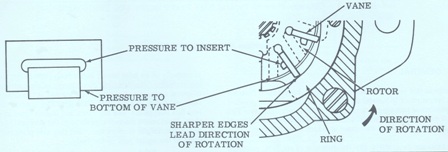Vickers Hydraulic Single Pumps 20VQ, 25VQ, 35VQ and 45VQ
Posted by Tammy Soper on
Vickers Hydraulic Single Pumps 20VQ, 25VQ, 35VQ and 45 VQ
Pumping Cartridge
Fluid flow starts in the pumping cartridge. The rotor starts within the ring where the drives shaft is that is attached to a power source. You will notice when the rotor turns the centrifugal force on the vanes, that are guided by under vane pressure that is fed by the outlet port. This will make the vanes want to go behind the elliptical inner surface of the ring.
When you have radial movement of the vanes and rotating of the rotor, it will make the chamber volume that is inside the vanes to enlarge as the vanes pass the inlet partitions of the ring. It will give you a low pressure condition that will let atmospheric pressure to force the fluid into the chambers. There is an extra fluid path that is drilled in the cam ring. The hole let’s the inlet port go directly into the inlet area of the cam ring and offers another flow path for the fluid to get to the cartridge.
When fluid is inside the vanes and taken beyond a sealing land to the outlet partition of the ring. Approaching the chamber volume is diminished and fluids is made to go into the system. Lastly, the system pressure is going under the vanes, thus making a seal go right upon the ring while it is in regular operation.
Vane Pressure Feed
This modification will give you a way of controlling the outward thrust of the vane next to the ring and holds loads stable and tip loads within limits. In the cartridge, they system holds the same amount of pressure in valve and insert. When the vane travel is applied thru pressure areas, this pressure is applied next to the bottom are of the outer vane. The valving of pressure goes thru holes drilled in the bottom are of the valve. This type of pressure keeps the same radial hydrostatic balance in all positions.
Call us for more information if needed at 800-361-0068
sales@hydrostatic-transmission.com


